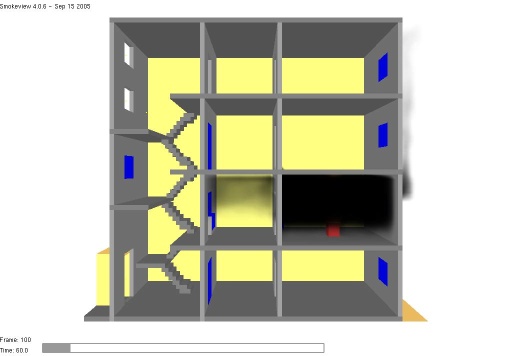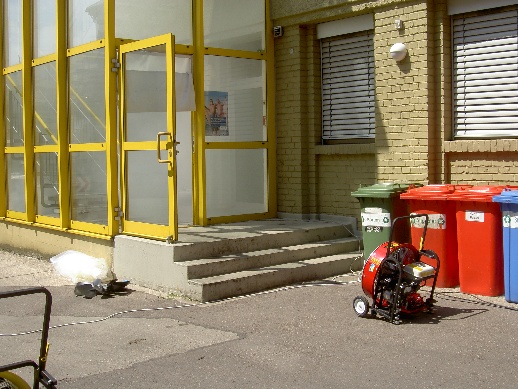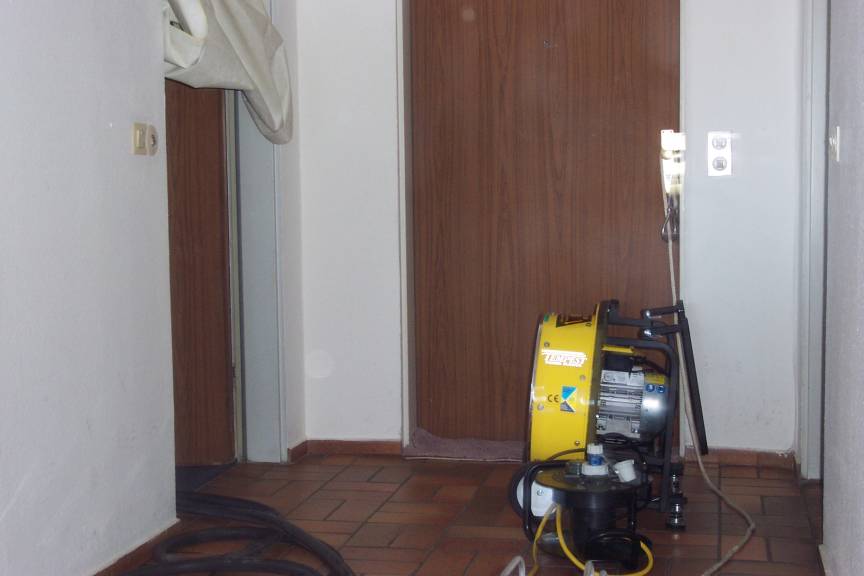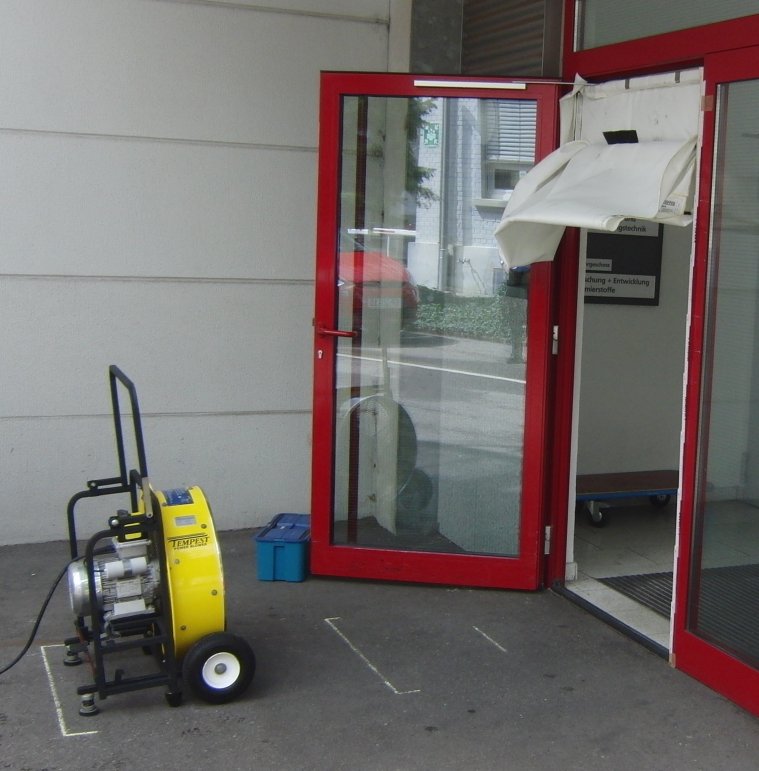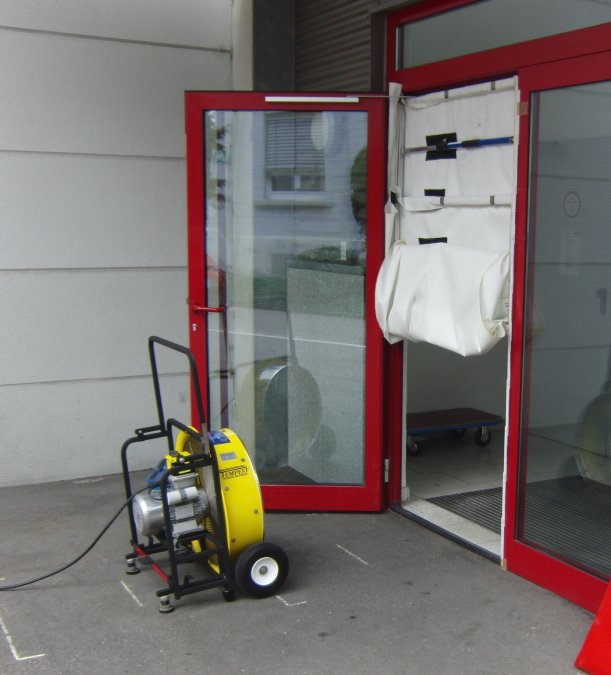By Michael Reick
The ability to control smoke flows in buildings in case of a fire is essential for safe rescue and firefighting operations. I have been discussing the importance of this task in various German firefighting magazines and books since 2005. Before fire crews are able to solve the problems on the fireground, they often have to stabilize the situation first and prevent it from getting worse. To do this, it is very important in multistory buildings to prevent smoke flows from entering escape routes and from leading to life hazards for civilians. For the life safety of civilians and firefighters in a building with a working fire, it is also of great importance to control the smoke flow and the flow of fresh air because they have a direct and immediate influence on the development and severity of the fire. For about 10 years, firefighters, especially in central Europe, use blocking devices to control these flows with great success. This article explains the background and some fields of application and shows some examples, out of more than 1,000 documented incidents, for their use in real building fires.
The most important task for firefighters is to save lives. In the case of fire in multistory residential buildings, this objective can be best achieved by using the stairways as the preferred route of attack. This method of entering a multistory dwelling ensures that the most important escape route for the inhabitants is immediately controlled, as people are often found in a smoke or in a still-safe and smoke‑free environment on their way out of the building.
Therefore, one of the most important aims for fire crews is to have a smoke-free and safe stairway. However, choosing the stairways as the preferred route of attack to a fire in a building means opening doors. Firefighting operations sometimes enable smoke to travel through a building, enter stairways, and endanger the inhabitants.
Figure 1. Smoke and Air Flows If the Door to the Fire Compartment Is Open


a) b)
Smoke spread in a stairway with open windows and an open door to the fire area (a) without and (b) with a ventilator in front of the main building entrance.
The problem of smoke spreading in a stairway is, unfortunately, not sufficiently solved by using a positive-pressure ventilator in front of the building entrance. It’s only when the ventilator is in an optimal position, with all windows and all other doors to the stairway closed that the complete ventilation process can be ensured. But what can firefighters do when this is not the case? What can be done in larger and more complex buildings where positive pressure ventilation is not possible? Considering this problem, there is a very simple objective that must be achieved: Firefighters need a means of closing and opening quickly and sufficiently sealing it against smoke and air flow, but without hindering firefighting operations. Fire crews must be able to prevent smoke from spreading with a simple method and be able to purge the building of smoke more easily. This would dramatically improve rescue operations and minimize smoke damage, and would also ensure a smoke-free escape route for firefighters, thereby leading to more safety even for themselves.
This can be shown by comparing Figures 1 and 2. Both figures are results from a numerical fire simulation, and they show the calculated smoke spread in a multistory building with mainly open windows and doors (a) without or (b) with a positive pressure ventilator in front of the main building entrance. Figure 1 shows the results if the entrance door to the fire compartment is open and not controlled. Using a ventilator, there is a better airflow through the stairway and, therefore, a reduced density of smoke, but smoke is still entering the stairway from the fire area through the upper part of the door. This flow will establish to some amount even if the entrance door is somehow controlled (e. g., opened only in a small angle by controlling it with one firefighter). Considering these flows, the situations 1a) and 1b) are not very efficient. Furthermore, there is also a lot of turbulence around the entrance to the fire compartment because of the bidirectional flow through the door frame.
The use of a portable smoke-blocking device that blocks the flow at least in the upper part of the entrance door hinders smoke from flowing into the stairway but allows a smaller amount of fresh air to enter the fire compartment at floor level. Both situations in Figure 1 can be transferred and improved. Figure 2 easily demonstrates that flows in a building are much simpler and easier to control if the upper half of the entrance door is blocked. Ideally, the stairway remains smoke free or can be freed from smoke more easily. Turbulences around the entrance to the fire area should be reduced and fresh air enters the fire area in a smaller amount and only at floor level. Therefore, the work of firefighters in the fire compartment becomes easier and safer, and smoke can leave the fire area through open windows.
Figure 2: Smoke and Air Flows If the Door to the Fire Compartment Is Blocked in the Upper Half


a) b)
Smoke spread in a stairway with open windows and an open door to the fire area (a) without and (b) with a ventilator in front of the main building entrance.
If the entrance door needs forcible access anyway, it might be possible to cut the lower half of the entrance door by using a saw or some other tool. This idea was tested in training fires but, obviously, has some disadvantages and risks. Therefore, the need to build an easy device to perform this task fast and easy was identified in 2005.
Many various designs for a smoke-blocking device were built and tested in 2005. The best results to control all flows have been achieved by using a combination of a metal frame with a spreader and a special textile fiber curtain. Obviously, the curtain had to meet many requirements for safety and practical reasons. In addition, it was found to be very favorable if the curtain also influences the characteristics of the fresh air flow into the fire compartment. Looking at the flow of smoke shown in Figure 2, the curtain must prevent smoke from travelling through the upper part of a door but must still allow fresh air to travel into the fire area through the lower part of the door (this fresh air, however, must flow with much less turbulence to prevent excessive mixture of fresh air and smoke). This keeps the volume of smoke to be expelled from the building to a minimum and improves the conditions and safety for firefighters by leading to lower temperatures and better visibility in the lower layer. Keeping the layers of cold air (with only a little smoke) in the lower half and smoke in the upper half more distinguished should also result in a smaller smoke layer which is premixed with the necessary amount of oxygen from the fresh air flow.
In the recent years, there have been multiple studies in the United States from the National Institute of Standards and Technology and Underwriters Laboratories showing the big influence of the fresh air flow on fire development. In ventilation-controlled fires, the time between opening a door to a fire compartment and the time a flashover will occur was investigated. Because of the higher heat release rate of modern furnishings, it was shown that the time span from starting ventilation (e.g., opening a door) and a flashover in the fire compartment decreases to about one to two minutes. For the safety of all life in the fire compartment and the adjacent rooms in the building, this fire development must be prevented. Therefore, it is highly advised that the flow of fresh air be reduced. This can be done by keeping the door closed as much as possible, even after the fire crew accesses the fire compartment. This “door control” might be done using a chock to fix the door in a nearly closed position. Because this might hinder the egress of firefighters, it is advised that another firefighter control the entrance door. Unfortunately, the required staffing to do this is often not available in this stage of firefighting. Despite the fact that a “door control” with a portable blocking device mounted into the door frame is more effective in the upper half of the door, the curtain used can also positively influence the flow pattern in the lower half of the door by forcing the flow of fresh air to go low into the fire compartment. This reduces the mixing of smoke and fresh air to reach an ignitable mixture and gives the firefighters, and maybe the victims in the fire room, better conditions in a layer close to the floor–and this is where this is needed.

(1) The influence of a smoke-blocking device with a curtain that nearly covers the whole opening and forces the fresh air flow to go in low.
It must be emphasized at this point that underventilating a fire in a compartment can lead to a higher amount and concentration of combustible gases. Going in a fire compartment even with the mandatory personal protective equipment is still dangerous. Smoke layers, which are hot and contain combustible gases, should be cooled to further reduce their ability to ignite.
In hundreds of real fires in buildings, it was shown that blocking the upper half of the entrance door and entering the fire compartment with a limited, but still present, flow of fresh air (one-directional flow) worked well. This limited air flow still improves visibility, reduces the temperature in the lower area, and shows outgassing and flaming combustion, especially in this area. Firefighters use their hoseline and extinguish the fire and cool the smoke layer and maybe other surfaces as they enter the fire compartment. The lower amount of the ingoing flow of fresh air should increase by a few minutes the time between the start of ventilation (opening the door) and a flashover in the fire compartment; this should allow firefighters to get water on the seat of the fire. In addition, the danger for firefighters encountering a bidirectional flow (hot smoke out high and fresh air in low) while advancing into a fire compartment is reduced. With a smoke-blocking device as described in this article it should be possible to transform this bidirectional flow into a one-directional flow in the same direction as the firefighters are entering the compartment.
The curtain also must be resistant to high temperatures, flames, and mechanical damage. After using a portable smoke-blocking device, the device should be able to be cleaned easily and, therefore, needs to be impregnated against dirt and water accordingly. This portable smoke-blocking device for firefighting operations is shown in Photos 2-4.



(2-4) Portable smoke-blocking device: Door before installation of the device; (3)
Installation of a smoke-blocking device; and (4) Easy access for firefighters to the fire area.
There are many situations and, therefore, multiple reasons for using a portable smoke-blocking device in almost all firefighting operations in buildings:
· In multistory buildings: The stairway stays smoke-free and/or smoke already in the stairway can be expelled much faster.
· The portable smoke-blocking device can serve to close an open or damaged door to prevent the spread of smoke in a building.
· A smoke-free stairway enables the rescue team to stay closer to the fire area and, therefore, communicate more easily with the attack team. This results in a shorter escape route and improved safety for firefighters.
· With a portable blocking device, the positive-pressure ventilation of a stairway in a building is much easier to achieve, and ventilation operations can be effected section by section.
· The limitation of flows can favorably lead to a reduced air flow to the fire, thus leading to a smaller heat release rate and a less severe fire development.
In case of an underventilated, the time between the opening of an entrance door and a flashover in the fire compartment should be increased to an amount of time that allows firefighters to extinguish and control the fire before fire development happens.
· In case of an unexpected happening (e.g., the failure of a window or the opening of other doors in the building), which might lead to rapid changes in the flow of smoke and hot fire gases and life-threatening hazards for firefighters, the installation of portable smoke-blocking devices will help to stabilize these situations. Everything should be done to help prevent the interior attack crew from getting into the flow path between the fire and its outlet.
In addition, firefighters often underestimate damage caused by the spread of smoke. The use of a portable smoke-blocking device has already prevented a lot of smoke damage. Many people affected by a fire have recognized the advantages of using such a device. For firefighters, this easy and visible separation of “black” and “white” areas leads to a very different behavior at the fireground and a more conscious strategy regarding smoke damage.
As one example of many fire incidents thus far, photos 5-7 show a fire in a residential building in Heilbronn (Germany) which occurred on 6th February 2006. The fire area itself (a child’s room) was totally damaged by heat and smoke whilst the corridor suffered considerable damage. The portable smoke blocking device placed in the doorway to the apartment efficiently prevented smoke from entering the stairway. The firefighters entering the fire compartment were able to go in with a one- directional flow in their direction.



(5-7) This fire occurred in a multistory dwelling in Heilbronn, Germany on Feb. 6, 2006.The fire room was totally damaged, and the corridor was considerably damaged by heat and smoke. Meanwhile, the stairway was protected efficiently by using a portable smoke-blocking device.
The general use of a portable smoke-blocking device can prevent the spread of smoke caused by fires in buildings, leading to much lower risks for occupants and a massive reduction in smoke damage. This is a simple and efficient method for preventing the spread of smoke not only in residential buildings but also in modern structures with an open architecture. The closing of an opening during building fires is a very basic and important task. The use of a portable smoke-blocking device allows fire crews to control the flow of smoke in structural fires more easily. This leads to improved safety for occupants and firefighters, easier rescue operations, and less damage. Information on more than a thousand uses of these devices in real building fires can be found at www.smokeblockingdevice.eu.
Combination of two portable smoke blocking devices
In addition to the basic use of a portable smoke blocking device as shown in Figure 5, a combination of two portable smoke blocking devices is just as simple and easy. Figure 7 shows how this enables the almost total sealing off of an opening to prevent smoke spread. However, access to the room for firefighting operations is also limited.


(8-9) The basic use of a portable smoke-blocking device.


(10-11) A combination of two portable smoke-blocking devices: A second portable smoke-blocking device is fastened in the middle of a door.
Smoke spread is limited even further, but access to the room is still possible. (11) A second portable smoke-blocking device is fastened at the bottom of a door.
There is practically no smoke spread possible, but access to the room is hindered.
Danger of Backdraft Figure 3: Six Stages of a Backdraft (according to Gottuk)
|
Opening a door to a fire area is always accompanied by the risk of a backdraft. This does not happen very often, but firefighters must always be aware of this hazard. Figure 3 shows the six stages of the development of a backdraft (according to Gottuk).
To reduce the risk of a backdraft, it is interesting to consider the effect of a portable smoke-blocking device on the movement of smoke and fresh air. The flow of smoke and fresh air without a portable smoke-blocking device is illustrated on the left side of Figure 4. Under the same conditions, but with a portable smoke-blocking device fastened in the door, the result is illustrated on the right side. |
|
Figure 4: Smoke Spread and Mixing of Smoke and Fresh Air After Opening a Door to a Fire Area 
The left side shows the condition without a portable smoke-blocking device, and the right side with a portable smoke-blocking device. (The steps in the flexible material of the portable smoke-blocking device are a result of the modeling and are necessary for the numerical calculations.)
When opening a door, the movement of fresh air into the fire area can easily be seen when a portable smoke-blocking device is installed (photo 12). If the room “sucks in fresh air” (one indication of an ensuing backdraft), or if the room seems to be very hot (perhaps just before a flashover occurs), the door can be closed again and safe firefighting tactics can be employed as shown in Figure 4 of maybe by using another opening to the fire compartment.
|
|
(12) A portable smoke-blocking device makes airflows visible. You can see the movement of air into a fire area and get a safe view into the room.
|
|
|
(13) Using two portable smoke-blocking devices. The second metal frame holds the fireproof curtain of the first portable smoke-blocking device in place. A nozzle can be used through the nearly closed opening and a very safe firefighting technique can be employed – without the infiltration of fresh air (and oxygen) into the fire area. This might also be used in wind-influenced or wind-driven fires. |
Black Areas / White Areas
To have less damage and pollution in the rooms adjacent to the fire area, it is advisable to use a clear sign to create a barrier against all unnecessary access to the main fire area. Photo 14 shows that a brief look into the fire area is often enough for most investigation purposes.
|
|
(14) A portable smoke-blocking device is a barrier between black and white areas.
|
Figure 5. Creating a Black, Grey, and White Area in a Building
|
|
Using two portable smoke-blocking devices is an effective method for creating a grey area between the black and the white areas. This helps to prevent the spread of smoke and dirt through the building.
|
Closure against Dirt and Dust
Fire crews often have to open walls to find the fire, which helps a lot of dirt and dust find its way throughout the building. A portable smoke-blocking device acts as a barrier that can limit the spread of dirt and dust.
|
|
(15) A portable smoke-blocking device is used as a curtain to prevent the spreading of dirt and dust.
|
An Additional Tool for Negative Pressure Ventilation
Photos 16-18 show the setup for negative pressure ventilation after a small fire in a room at an airport terminal in Stuttgart, Germany.
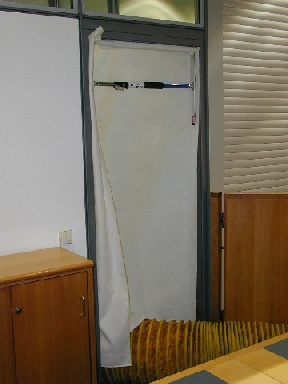
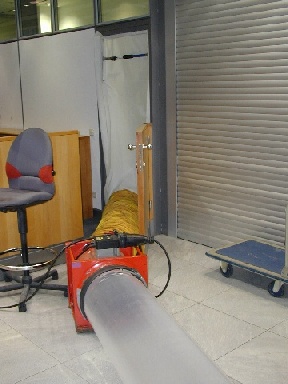

(16-18) A room fire at an airport terminal in Stuttgart. To prevent smoke from spreading during the ventilation process, the door can be closed with a portable smoke-blocking device.
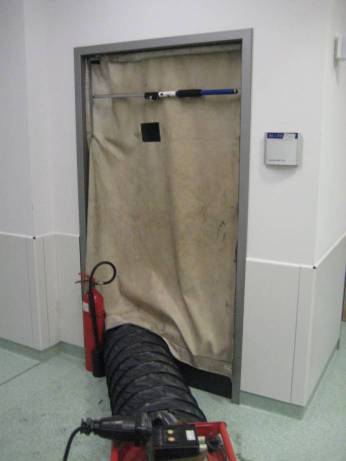

(19-20) This room fire in a hospital in Würzburg, Germany (Nov. 26, 2009) shows the effect of a portable smoke-blocking device used in a hospital. The hazard for the patients was limited because smoke spread was hindered effectively.
An Additional Tool for PPV in Special Geometric Situations
For good PPV, it is often recommended to cover the entire opening of a door with the flow of air. At least, the aim should be to achieve a best fit between the flow pattern and the opening. Depending on the geometry of the entrance, this could require placing the ventilator far away from the door, which is ineffective and sometimes unfeasible. By closing the upper part of the door, the entrance area for PPV is reduced in height while the entrance area is transformed into the shape of a square. This increases the effectiveness of using PPV because the ventilator can then be placed closer to the entrance and cover the entire opening.
|
|
(21) Stairs in front of the entrance. By using a portable smoke-blocking device in the upper part of the door (the lower part of the fireproof curtain is hung over the spreader bar of the metal frame), the PPV method becomes more effective. |
|
|
(22) Stairs in front of the entrance. The ventilator may be placed directly in front of the entrance when employing a portable smoke-blocking device. A large ventilator can even be placed very close to the door when a portable smoke-blocking device is used. The PPV method then becomes even more effective.
|
|
|
(23) Corridor situation in a multistory or high-rise building. The ventilator can be placed in an effective position in a small corridor in a building when the upper part of the entrance door is blocked with a smoke-blocking device.
|
An Additional Tool for Positive Pressure Ventilation to increase the differential pressure in the stairway
Since the shape of the air flow is nearly a circle, the shape of the entrance should be changed from a rectangle to a square. This will reduce the loss of air flow at the entrance door of a building.
Figure 6: Comparison of a Rectangular Door and a Circle (a) and a Square and a Circle (b)

Tests in a building with four floors showed that the differential pressure in the stairway could be increased by 50 percent with one blocking device and 100 percent with two blocking devices (photos 24-25). This is a very easy method for increasing the power of a smaller blower. Used together with a stronger blower, this method can ensure a sufficient differential even in higher buildings. In addition, the use of a blocking device in an entrance door is a good way to show all other people on a fire scene that nobody should access the building in this stage. The blocking device, together with a ventilator directly in front of the building, is a very easy and efficient method to achieve limited access.
|
(24) The pressure difference can be increased by 50 percent by using one blocking device installed in the entrance door of a building. The distance from the blower to the entrance door should be about the open height of the door. |
(25) The pressure difference can be increased by 100 percent by using two blocking devices installed in the entrance door of a building. The distance from the blower to the entrance door should be about the open height of the door. |
Developed in 2005, the first portable smoke-blocking devices were first used Germany by several innovative fire departments. After a lot of experience in real fires and some improvements–and because of their very good acceptance and impressive reports from real fires–less than 10 years later, more than 14,000 portable smoke-blocking devices are in use.
|
Note: One of the most common booklets in Germany for firefighters is “Die Roten Hefte.” The book Nr. 212, published in its third edition in 2012, explains the basic theory and shows a lot of pictures for the safe and powerful use of a portable smoke BlockAID. Die Roten Hefte / Ausbildung kompakt Band 212 ISBN 978-3-17-022359-2 |
|
BIO
MICHAEL REICK has been a research engineer and the leader of the Fire Research Laboratory at the University of Stuttgart for several years. He has had 12 years of experience as a volunteer firefighter and served as a career firefighter from 1999 to 2001. He is a regional fire commander and a part-time lecturer at the University of Applied Sciences in Biberach. He studied civil engineering at the University of Stuttgart and at the University of Calgary and has a doctorate degree; his specialty was the connection between steel and concrete under fire attack.




